Halva
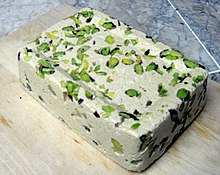 | |
| Type | Confectionery,dessert |
|---|---|
| Place of origin | Persia |
| Region or state | Middle East, South Asia, Central Asia, Balkans,South Caucasus,North Africa,Horn of Africa |
| Serving temperature | Cold |
Halva(alsohalvah,halwa,[1]and other spellings;Persian:حلوا) is a type ofconfectioneryoriginating fromPersiaand widely spread throughout theMiddle EastandSouth Asia.The name is used for a broad variety of recipes, generally a thick paste made from flour, butter, liquid oil, saffron, rosewater, milk, turmeric powder, and sweetened with sugar.[2][3][4][5]
Etymology[edit]
The wordhalvaentered the English language between 1840 and 1850 from Romanian, which came fromOttoman Turkish:حلوى,romanized:helva,itself ultimately derived fromArabic:حلوى,romanized:ḥalwā,a sweet confection.[6][7]The root in Arabic:ح ل و,romanized:ḥ-l-w,means "sweet".[8]The original name for the confection wasPersian:روغن خورديگ,romanized:rōγn xwardīg,meaning "oil food".[9]
History[edit]
Halva originated inPersia(modern dayIran).[9][10]A reference tohalvahappeared in the 7th century, referring to a mixture of masheddateswith milk. By the 9th century, the term was applied to numerous kinds of sweets, including the now-familiar sweetened cooked semolina or flour paste.[2][6]
Many of the earlier Persian recipes were documented in the 13th centuryArabicbookKitab al-Tabikh(The Book of Dishes), as well as an anonymous cookbook from 13th-centuryAl-Andalus.Halva was adopted by theOttoman Turks,including a sesame-based version, and spread throughout their empire.[6]
Types[edit]
Most types of halva are relatively dense confections sweetened with sugar orhoney.[11]Their textures, however, vary. For example,semolina-based halva's texture can be like a very buttery, moist clumpy couscous[12]to something gelatinous and translucent, while sesame-based halva is drier and more crumbly.[13]
Grain-based halva[edit]
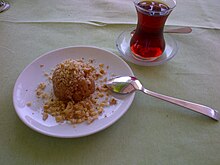
Grain-based halva is made by toasting flour or cornstarch in oil, mi xing it into aroux,and then cooking it with a sugary syrup. Corn is rarely used.
Dishes made from wheatsemolinaincludesuji ka halwa(sooji sheera,rawa sheera) in India andirmik helvasıin Turkey. The semolina is first toasted in fat, either oil or butter, to which water or milk, and sugar is added as desired to create the preferred taste and consistency.[14]
Dairy-based rice flour halva, known asPathein halawa,is considered a Burmese delicacy native to the city ofPathein.
Sesame[edit]
Sesamehalva is popular in the Balkans,Poland,the Middle East, and other areas surrounding the Mediterranean Sea. The primary ingredients in this confection are sesame butter or paste (tahini), and sugar, glucose or honey.[2]Soapwort[15][16](called‘erq al halawehin Arabic;çövenin Turkish), egg white, ormarshmallow rootare added in some recipes to stabilize the oils in the mixture or create a distinctive texture for the resulting confection. Other ingredients and flavorings, such aspistachionuts,cocoa powder,orange juice,vanilla,or chocolate are often added to the basic tahini and sugar base.[2][17]
Sunflower[edit]
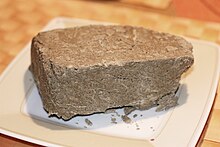
Sunflowerhalva is popular in thecountries of the former Soviet Unionas well as inBulgariaandRomania.[18]It is made of roasted groundsunflower seedsinstead of sesame. It may include other ingredients, such as nuts, cocoa powder, or vanilla.[19][20]In 1996 around 4–5 thousand tonnes of sunflower halva were being produced by Ukraine annually.[21]
Peanuts[edit]
In Argentina, Greek immigrants at the beginning of the 20th century created a kind of halva calledmantecolfrom peanut butter, currently marketed under the name of Mantecol and also Nucrem. Such a product is widely consumed in the country.
Other[edit]
Floss halva[edit]
Pişmaniye(Turkish) orfloss halvais a traditional sweet, prepared inKocaeli,Turkey, made by flossing thin strands of halva into a light confection. Made primarily of wheat flour and sugar, the strands are continuously wrapped into a ball shape and then compressed. The result is a halva with a light consistency, similar tocotton candy.Floss halva can be found in regular and pistachio flavors, and there are brands withhalalorkoshercertifications.
A similar chickpea-based, version of floss halva is popular in North India. It tends to be slightly denser and is often referred to aspatisaorsohan papdi.In Chinese cuisine, a floss-like candy similar topişmaniyeorpashmak halva,known asdragon beard candy,is eaten as a snack or dessert.
A raw version of halva also has become popular among proponents of raw food diets. In this version, a mixture of raw sesametahini,rawalmonds,rawagave nectarand salt are blended together and frozen to firm.[22]
Cultural and national variations[edit]
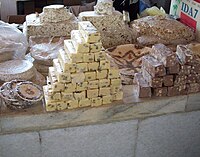
Azerbaijan[edit]

One regional variant is fromShekiwhereŞəki halvasıhalva refers to a layeredbakhlavastyle pastry filled with spiced-nut mix and topped by crisscrossed patterns of a red syrup made from saffron, dried carrot and beetroot.[23][24]
Greece[edit]
Halva is a traditional fasting food among Greek Orthodox who traditionally have food restrictions, especially from meat, on Wednesdays and Fridays throughout the year, for all ofGreat Lentand other fasting periods.[25]
India[edit]


India has many types of halva, some unique to particular regions of the country. It is one of the popular sweets of India usually made from semolina.[26]
The town ofBhatkalinCoastal Karnatakais famous for its unique Banana Halwa which is infused with either whole cashews, pistachio or almonds. This type of authentic halwas are a specialty of the Muslims of this town. The Udupi cuisine has halwa's made from Banana, Wheat, Ashgourd, and Jackfuit, etc.[27][28]
It is speculated that Halva (or Halwa) is associated with Indian traditions and culture, written records of sweets fromMānasollāsaindicate that semolina halvas, the most popular form of halvas in India, were already known in India, for instance, it mentions a sweet calledshali-annawhich is a semolina based sweet today known asKesariin South India.[29]
Tirunelveliin Tamil Nadu is known for its wheat halwa. Its preparation is a laborious process that "is slowly seeing this sweet disappear." Unlike other sweets, the extra ghee is not drained out but forms an outer layer. This increases the shelf life of the halwa. Locals attribute the unique taste of the halwa to the water of theThamirabarani.[30]
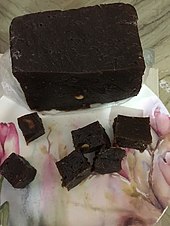
The history ofKozhikode HalwainKeralacould trace back toZamorin era.Zamorin invited chefs fromGujaratto prepare halwa for their royal feast.[31]They were also granted places to stay beside royal kitchen. This settlement later evolved as sweet sellers street, nowadays known asSM (Sweet Meat) StreetorMittayitheruvu.[32]Kozhikode halwa is made of pure coconut oil, not from ghee. Kozhikode halwa also builds religious harmony;Ayyappadevotees from neighboring statesKarnatakaandAndhra Pradeshbuy halwa and chips like prasadam (sacred food). They distribute them among their neighbors and friends, who consume them with a religious zeal.[33]
Iran[edit]
InIran,halva(Persian:حلوا) usually refers to a related confection made from wheat flour and butter and flavored withsaffronandrose water.[34][35]The final product has a yellow color or brown color or dark brown color. The halva is spread thin on a plate till it dries into a paste. Halva usually is served at wedding celebrations, religious ceremonies and funerals.

Halva Ardehis the Iranian term for tahini-based halva, and may or may not include whole pistachios.Ardehis processed sesame in the form of paste, usually sweetened withsyrup.[36][37]
Israel[edit]
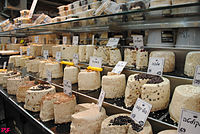
Tahini halvah (Hebrew:חלווה) is very popular in Israel and among Jews in the diaspora.[38][39]Israeli halvah is made fromsesametahiniand sugar. It is generally sold in slabs, with or without nuts. Vanilla, or vanilla with chocolate swirls are perhaps the most common, but there are many different varieties. Halvah isparve.It is often served as a breakfast component at Israeli hotels, and even used in specialtyice cream.[40]
Myanmar (Burma)[edit]
InMyanmar(Burma),halawa(ဟလဝါ) generally refers toPathein halawa(ပုသိမ်ဟလဝါ), a Burmese confection ormontmade withglutinous rice flour,rice flour,milk, and coconut shavings originating from theIrrawaddy deltatown ofPathein.Another popularsemolina-based confection, which is known as sooji halawa in India, is calledsanwin makinin Myanmar.
Turkey[edit]
InTurkeyhalva is served for special occasions such as births, circumcisions, weddings and religious gatherings. The tradition is for semolina halva to be served at funerals, when someone leaves or returns fromHajj,and duringRamadan.[41]
For this reason, flour (un) halva is also called in Turkishölü helvası,meaning "halva of the dead". The expression "roasting halva for someone" suggests that the person referred to has died.
United States[edit]
Halva can be found in ethnic Indian, Jewish,[6]Arab, Persian, Greek, Balkan, and Turkish community stores and delicatessens. It is increasingly offered by upscale restaurants in some areas.[42]Besides being imported, it is manufactured in the United States, with the largest producer being Brooklyn-originatedJoyva.[43][1]
See also[edit]
References[edit]
- ^abClark, Melissa (March 24, 2004)."For Halvah, Use 1/2 Cup Nostalgia".The New York Times.RetrievedNovember 15,2020.
- ^abcdDavidson, Alan(1999).The Oxford Companion to Food.Oxford: Oxford University press. p. 378.ISBN0-19-211579-0.
- ^Sharar, Abdul Halim (1994).Lucknow: the last phase of an oriental culture.Oxford University Press. p. 165.ISBN9780195633757.
- ^Hosking, R. (2010).Food and Language: Proceedings of the Oxford Symposium on Food and Cooking 2009.Proceedings of the Oxford Symposium on Food and Cookery Series. Prospect Books. p. 202.ISBN978-1-903018-79-8.RetrievedApril 11,2022.
- ^Szokovski, Miriam."How to Make Halva at Home".
- ^abcdMarks, Gil(2010)."Halva".Encyclopedia of Jewish Food.HMH.ISBN9780544186316.
- ^HalvahArchivedMarch 6, 2016, at theWayback Machine,Random House Dictionary,2009
- ^"American Heritage Dictionary".RetrievedFebruary 21,2019.
- ^abFoundation, Encyclopaedia Iranica."Welcome to Encyclopaedia Iranica".iranicaonline.org.RetrievedApril 23,2021.
The origin of ḥalwā in Persia dates from the pre-Islamic period. References are found in the Middle Persian text of Xōsrōv ud rēdak (ed. Monchi-zadeh, secs. 38-40) to two kinds of sweetmeats (rōγn xwardīg): (1) summer sweetmeats, such as lōzēnag (made with almond), gōzēnag (made with walnut), and čarb-angušt (made from the fat of bustard or gazelle and fried in walnut oil); and (2) winter sweetmeats, such as wafrēnagītabarzad flavored with coriander (gišnīz ačārag). Many references are found to ḥalwā in classical Persian texts, but rarely do they provide details concerning ingredients.
- ^Marks, Gil (November 17, 2010).Encyclopedia of Jewish Food.HMH.ISBN978-0-544-18631-6.
Halva is a dense confection. The original type is grain based, typically made from semolina, and another kind is seed based, notably made from sesame seeds. Origin: Persia
- ^Kobren, Gerri (August 17, 1983)."What's this stuff called halvah?".The Herald News (Passaic, New Jersey).Independent Press Service. p. C-4.RetrievedAugust 17,2022– via Newspapers.
- ^"Suji ka Halwa | Sheera Recipe".July 3, 2021.
- ^Shah, Khushbu (June 8, 2017)."Halwa vs. Halvah: An Investigation".Taste.RetrievedMarch 8,2019.
- ^Segnit, Niki (2019).Lateral Cooking.Bloomsbury. p. 83.ISBN9781635574418.
- ^Arndt, Alice (1999).Seasoning Savvy: How to Cook with Herbs, Spices, and Other Flavorings.Taylor & Francis. p. 215.ISBN978-1-56022-031-2.
- ^"HalvaEthnological Museum of Thrace ".Archived fromthe originalon July 3, 2007.
- ^"HALWA+WITH+PISTACHIO" "Halwa with pistachio".FAO Food and Nutrition Paper.25–28. Food and Agriculture Organization of the United Nations. 1982.
- ^Nistor, E.; Hoha, G.; Usturoi, M.; Alley, M. S. (2014)."Comparison of three sunflower halva assortments from Romanian market"(PDF).Analele Universității din Oradea, Fascicula: Ecotoxicologie, Zootehnie și Tehnologii de Industrie Alimentară.14(B): 329–336.S2CID54789320.
- ^"Халва. Общие технические условия",Гост 6502-2014,Межгосударственный совет по стандартизации, метрологии и сертификации, 2014["Halva. General specifications",Interstate Standard GOST 6502-2014(in Russian), Euro-Asian Council for Standardization, Metrology and Certification, 2014]
- ^"Халва".ГОССТАНДАРТ."Halva"(in Russian). GOSSTANDART. Archived fromthe originalon January 13, 2021.RetrievedMay 1,2019.
- ^Volodymyrovych, Dmytro (1996).Ukraine 5 years of Independence.Politische Geschichte.ISBN9789667127008.
- ^Amsden, Matt (2006).RAWvolution: Gourmet Living Cuisine.HarperCollins.ISBN978-0-06-084318-2.
- ^"Visions of Azerbaijan Magazine::: SHEKI'S MYSTERIES – STAINED GLASS AND THE SWEETEST HALVA".Visions of Azerbaijan Magazine.
- ^"Mətbəx sirləri: Şəki halvası - VİDEO".Milli.Az.March 20, 2013.
- ^Moskin, Julia (April 11, 2016)."Sesame Extends Its Sweet Reach Beyond the Middle East".The New York Times.
- ^Bahadur, Om Lata (1996).The book of Hindu festivals and ceremonies(3rd ed.). New Delhi: UBS Publishers Distributors ltd. p.172.ISBN81-86112-23-5.
- ^"ash gourd halwa recipe kashi halwa kushmanda halwa dumroot halwa".Hebbar's Kitchen. February 12, 2019.RetrievedMarch 22,2024.
- ^"jackfruit halwa recipe seasonal dessert".Udupi recipes. June 3, 2017.RetrievedMarch 22,2024.
- ^"Full text of" Indian Food Tradition A Historical Companion Achaya K. T. "".archive.org.RetrievedJanuary 30,2019.
- ^Rajagopalan, Ashwin (May 10, 2018)."Tirunelveli Halwa: Tamil Nadu's Legendary Red Wheat Halwa You Need to Try".NDTV Food.RetrievedAugust 20,2019.
- ^"kozhikode-calicut-halwa-food-history".onmanorama.
- ^Basheer, K. p m. (December 22, 2017)."a-sweet-place-in-their-hearts".The Hindu.
- ^Naha, Abdul Latheef (December 13, 2015)."kozhikodan-halwas-religious-flavour".The Hindu.
- ^Fair, Chris (August 3, 2008).Cuisines of the Axis of Evil and Other Irritating States.Rowman & Littlefield.ISBN978-1-59921-634-8.RetrievedNovember 1,2020.
- ^"Recipe".Archived fromthe originalon February 19, 2009.RetrievedDecember 5,2008.
- ^Floor, Willem M. (2003).Traditional Crafts in Qajar Iran (1800-1925).Mazda Publishers.ISBN9781568591476.
- ^Ying, Chris; Redzepi, René (2018).You and I Eat the Same: On the Countless Ways Food and Cooking Connect Us to One Another (MAD Dispatches).Vol. 1. Artisan Books.ISBN9781579658564.
- ^Marks, Gil(1996).The World of Jewish Cooking.Simon & Schuster. p.210.ISBN978-0-684-82491-8.
- ^"Four stops for halvah".Haaretz.
- ^"The ice man cometh".Haaretz.
- ^Tremblay, Pinar (May 18, 2015)."Semolina halva unites Turks in times of joy, sorrow".Al Monitor (Turkey).RetrievedAugust 20,2019.
In Anatolia, the peninsula of land that today constitutes the Asian part of Turkey, halva has a social mission: it is shared with family and friends at joyous events such as weddings, births, circumcision ceremonies and religious celebrations. Traditionally, it is also served during Lent, at funerals and when someone leaves for hajj and is welcomed back home.
- ^Moskin, Julia (April 11, 2016)."Sesame Extends Its Sweet Reach Beyond the Middle East".The New York Times.ISSN0362-4331.RetrievedOctober 25,2017.
- ^DeLafuentenov, Charles (November 8, 2004)."A Longtime Brooklyn Company That's Known for Its Sesame Sweet".The New York Times.
- Confectionery
- Vegetarian cuisine
- Arab desserts
- Balkan cuisine
- Burmese desserts and snacks
- Iranian desserts
- Israeli desserts
- Israeli confectionery
- Jewish desserts
- Levantine cuisine
- Ottoman cuisine
- South Asian cuisine
- Uzbekistani cuisine
- Tajik cuisine
- Turkish desserts
- Halva
- Bulgarian cuisine
- Greek cuisine
- Semolina dishes
- Ancient dishes
- Lenten foods
- Breakfast
- Albanian cuisine
- Indo-Caribbean cuisine
